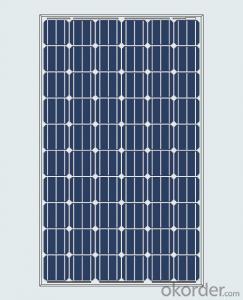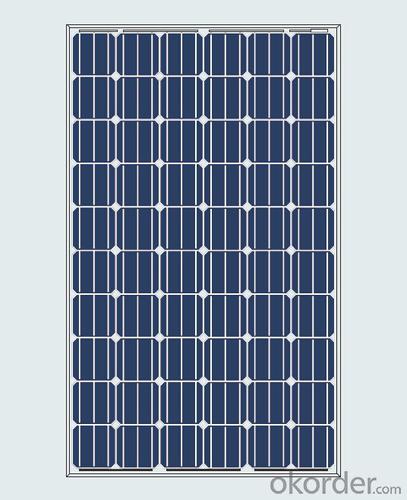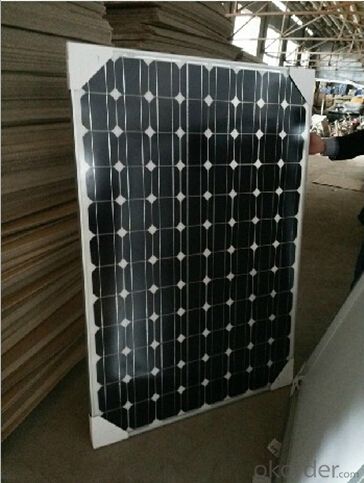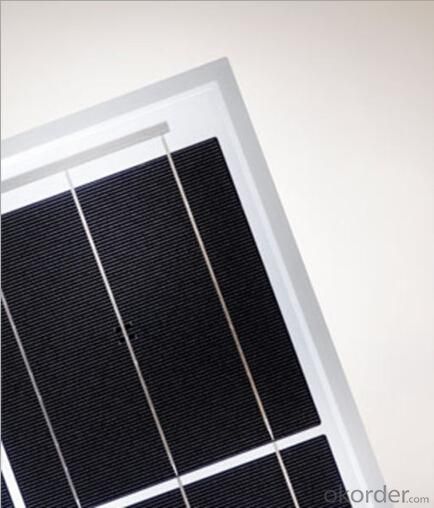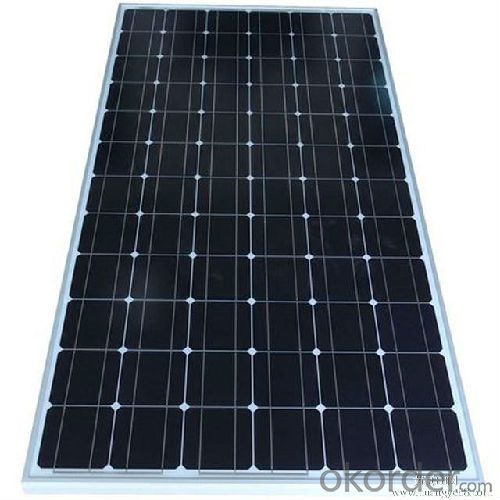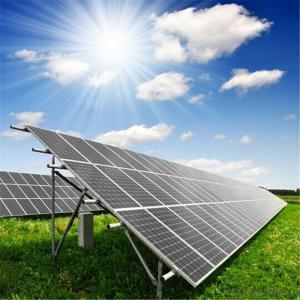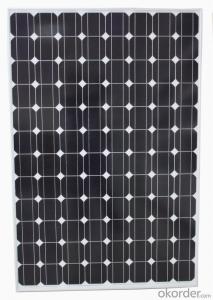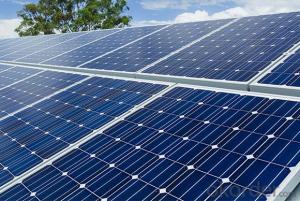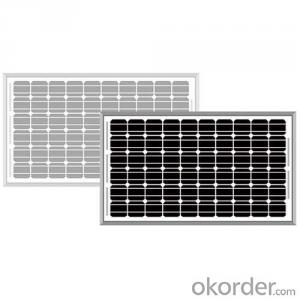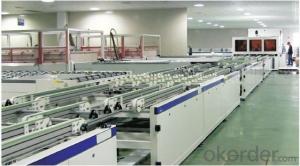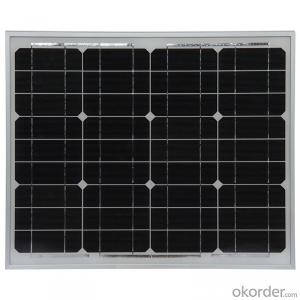Monocrystalline Silicon Solar &Panel Solar Module 300W
- Loading Port:
- China main port
- Payment Terms:
- TT or LC
- Min Order Qty:
- 50 pc
- Supply Capability:
- 10000 pc/month
OKorder Service Pledge
OKorder Financial Service
You Might Also Like
1.Structure of Solar Module Description
CNBM Solar's photovoltaic module is designed for designed for large electrical power requirement. It is the optimal choice for both on-grid and off-grid power systems. CNBM Solar offers high performance of power per square foot of solar array.
2.Main Features of the Solar Module
Solar Cell: High efficency crystalline solar cell. Even if under the weak light, the solar module can produce maximum power output.
Tempered glass: Anti-reflecting coating and high transmission rate glass increase the power output and mechanical strength of solar module.
EVA and TPT: Using high quality EVA and TPT to prevent destroying and water.
Strong aluminum frames to strengthen the load hold and to stand against high wind.
Junction box: Multi function junction box with water proof.
Long lifetime: ≥25 years; Less power decrease.
Good performance of preventing from atrocious weather such as wind and hails.
Resisting moisture and etching effectively, not effected by geology.
The certificate issued by international authority: UL, TUV, IEC, VDE, CE.
Quick Details
| Place of Origin: | Zhejiang China (Mainland) | Brand Name: | CNBM | Model Number: | FY-72-300M |
| Material: | Monocrystalline Silicon | Size: | 1956*992*50MM | Number of Cells: | 72PCS |
| Max. Power: | 300W | Color: | blue or black | Backsheet Cover: | TPT 0.3mm |
| Encapsulation Material: | EVA 0.5mm | Output Cable: | Length 900mm | Front Glass: | Low Iron,High Transmisson,Tempered glass |
| Junction Box: | IP65 rated | Solar Cell: | A grade | Frame: | Anodized,aluminum Alloy |
| Cable Connector: | MC4 | Certificaitons: | TUV,IEC/EN61215,IEC/EN61730,CE,IS |
Packaging & Delivery
| Packaging Detail: | Neutral standard Carton and Wooden Box |
| Delivery Detail: | 5-10 days after receiving deposit |
3.Solar Module Images
4.Solar Module Specification
300w mono yingli solar panel
1. high efficiency solar cell
2. mono or poly
3. CE,TUV,IEC
4. 10 years warranty
300W Solar Panel Specifications (Test condition: 1000W/m2, AM1.5, 25)
| Type Silicon Parameters | 300P | |
| Poly-crystalline silicon | ||
| Maximum Power | Watt | 230W |
| Production Tolerance | +3% /-3% | |
| Maximum Power voltage | V | 28.4 |
| Maximum Power current | A | 8.1 |
| Open circuit voltage | V | 35.6 |
| Short circuit current | A | 8.75 |
| Size of module (wide and high) | 1642mm x 992mm x 40mm | |
| Frame (type, material and thickness) | Anodized Alu. Alloy frame,40mm thickness | |
| Number of cells | 60pcs | |
| Size of cells (wide and high) | 156mmx156mm | |
| Weight per piece Kg | 24 | |
| Type of junction box | PV junction box | |
| Cable type and length, Connector type | PV cable, 0.8m Plug and socket | |
| Maximum system voltage | 1000V | |
| Temperature coefficient of Isc | +0.05%/oC | |
| Temperature coefficient of Voc | -0.34%/oC | |
| Temperature coefficient of power | -0.45%/oC | |
| Temperature coefficient of Im | +0.05%/oC | |
| Temperature coefficient of Vm | -0.34%/oC | |
| NOCT (Nominal operating cell temperature) | 47oC(+2oC) | |
| Insulation | >=100 MΩ | |
| Voltage Standoff | AC2000V, DC3000V | |
| Wind Bearing | 60m/s (200kg/sq.m) | |
| Impact Resistance Hail Impact Test | 227g steel ball fall down from 1m height | |
| CONVERSION EFFICIENCY | Cell CONVERSION EFFICIENCY >15.7% | |
| Quality guarantee | 5 years product warranty and 25 years -20% of power | |
5.FAQ of Solar Module
1. Q: Do you have your own factory?
A: Yes, we have. Our factory located in Jiangyin city, jiangsu province.
2. Q: How can I visit your factory?
A: Before you take off from your country, please let us know. We will show you the way,or arrange time to pick you up if possible.
3. Q: Do you provide free sample?
A: Usually we do not offer free sample
4. Q: Could you print our company LOGO on the nameplate and package?
A: Yes, we can do that.
- Q: Solar panels do good more then bad?
- Like any other materials, solar panels need to be manufactured. These components are usually imported, they use energy to produce and transport. However, once you install solar panels, they need little or no maintenance (except cleaning to maintain efficiency) and they use no other resources to produce power. Over their lifespan, they'll produce more energy than was used to be made, so on the whole good for the environment.
- Q: Can solar panels be installed on a metal roof?
- Yes, solar panels can be installed on a metal roof. In fact, metal roofs are often considered an ideal surface for solar panel installation due to their durability and longevity. The sleek, smooth surface of a metal roof provides an excellent mounting platform for the solar panels, and the panels can be easily attached using specialized mounting brackets designed for metal roofs.
- Q: Are solar panels durable?
- Yes, solar panels are durable. They are designed to withstand various weather conditions, including hail, snow, and strong winds. Additionally, most solar panels come with warranties that guarantee their performance for 25 to 30 years, indicating their long-lasting durability.
- Q: Are there any fire risks associated with solar panels?
- Yes, there are fire risks associated with solar panels, although they are relatively rare. The main risk factors include faulty installation, damaged wiring, and electrical malfunctions. However, adherence to proper installation standards, regular maintenance, and the use of high-quality equipment significantly mitigate these risks.
- Q: I've found something called maximum system voltage 000v on my 0 w panel nameplate. Its impossible for 0w to have 000v, right?
- Hi No i very much doubt it could produce that sort of voltage so get a voltmeter and check it. bright sunshine and dark.
- Q: i have this usb solar panel charger i am building and the solar panel is about 2by .5quot;, so i was wondering if a led light can power it, if so will one be good or would i need more? if so how many?
- An LED requires an electric current to power it. A solar panel can most definitely power an LED, but LEDs don't store any power themselves. And solar panels aren't designed to be powered, they are designed to generate electricity. Rethink your premise from the start. It is as if you were asking if the electric wires in your home or community would be powered by the light bulbs and appliances you use.
- Q: How do solar panels affect the overall carbon footprint of a building?
- Solar panels can significantly reduce the overall carbon footprint of a building. By harnessing the power of the sun to generate electricity, solar panels reduce the reliance on fossil fuels for energy production. This means that less greenhouse gases, such as carbon dioxide, are released into the atmosphere during the building's operation. Consequently, solar panels contribute to a cleaner and more sustainable energy system, helping to mitigate climate change and reduce the building's environmental impact.
- Q: how many solar panels in a grid tied system would it take to take see a difference in your power bill?
- Build okorder /
- Q: What are the different types of solar panels?
- There are three main types of solar panels: monocrystalline, polycrystalline, and thin-film. Monocrystalline panels are made from a single crystal structure, making them highly efficient but also more expensive. Polycrystalline panels are made from multiple crystal structures, offering a slightly lower efficiency but a more affordable price. Thin-film panels are made by depositing a thin layer of semiconductor material onto a substrate, making them flexible and lightweight, but with lower efficiency compared to crystalline panels.
- Q: How many solar panels do you need on your house to power your heater in winter?
- As a solar installer, I'd love to give you a simple answer but I can't. Most solar contractors offer a free solar evaluation where they will tell you how much energy they can generate given your site conditions, what it would cost, and how long the payback would be. Rather than a bunch of inexperienced people giving you a bunch of hypotheticals, I think this would be the best option.
Send your message to us
Monocrystalline Silicon Solar &Panel Solar Module 300W
- Loading Port:
- China main port
- Payment Terms:
- TT or LC
- Min Order Qty:
- 50 pc
- Supply Capability:
- 10000 pc/month
OKorder Service Pledge
OKorder Financial Service
Similar products
Hot products
Hot Searches
Related keywords
